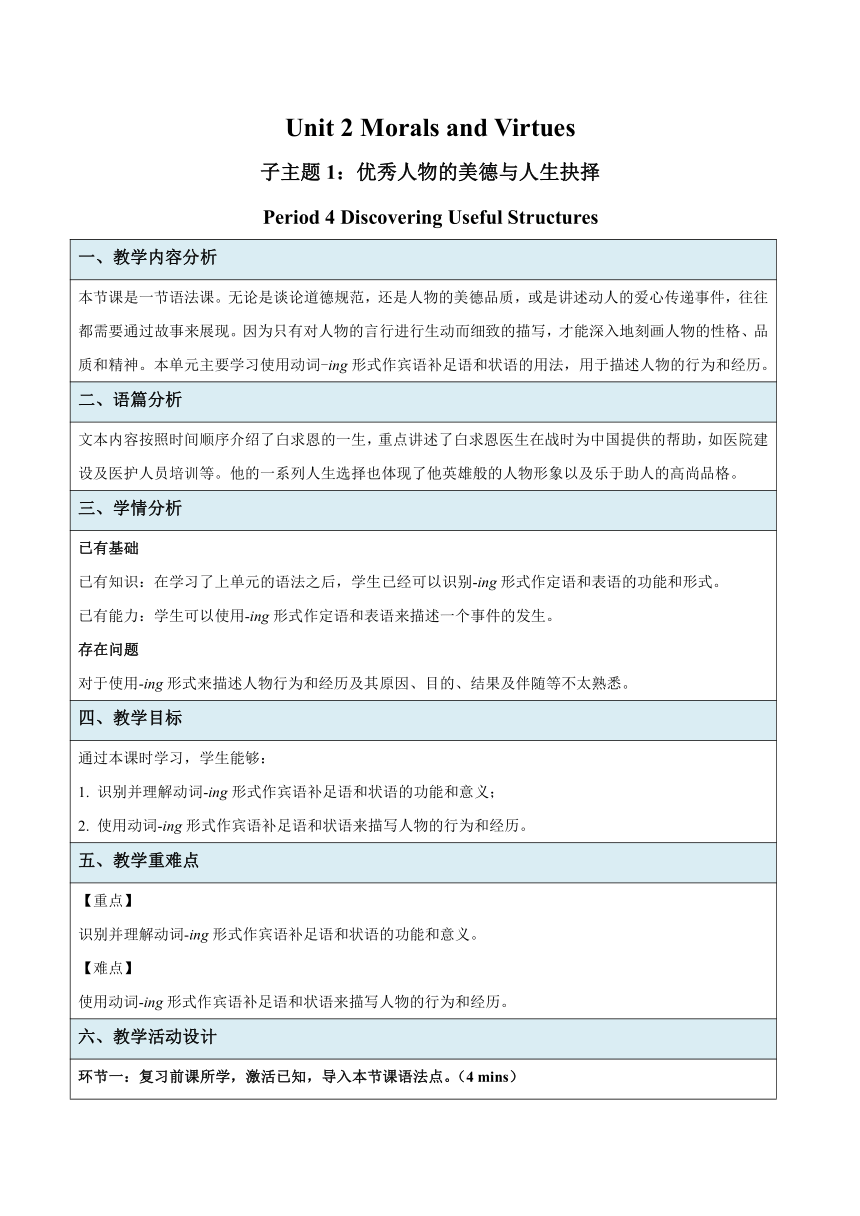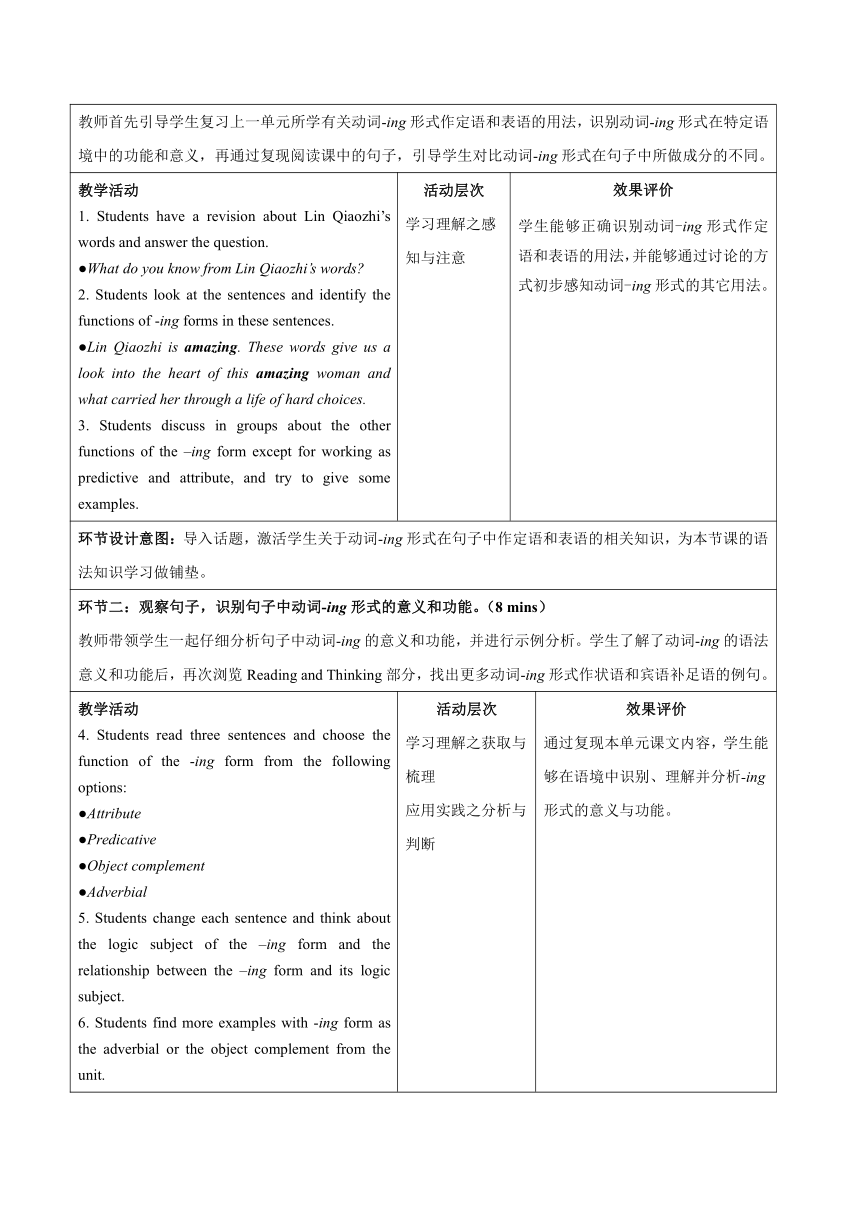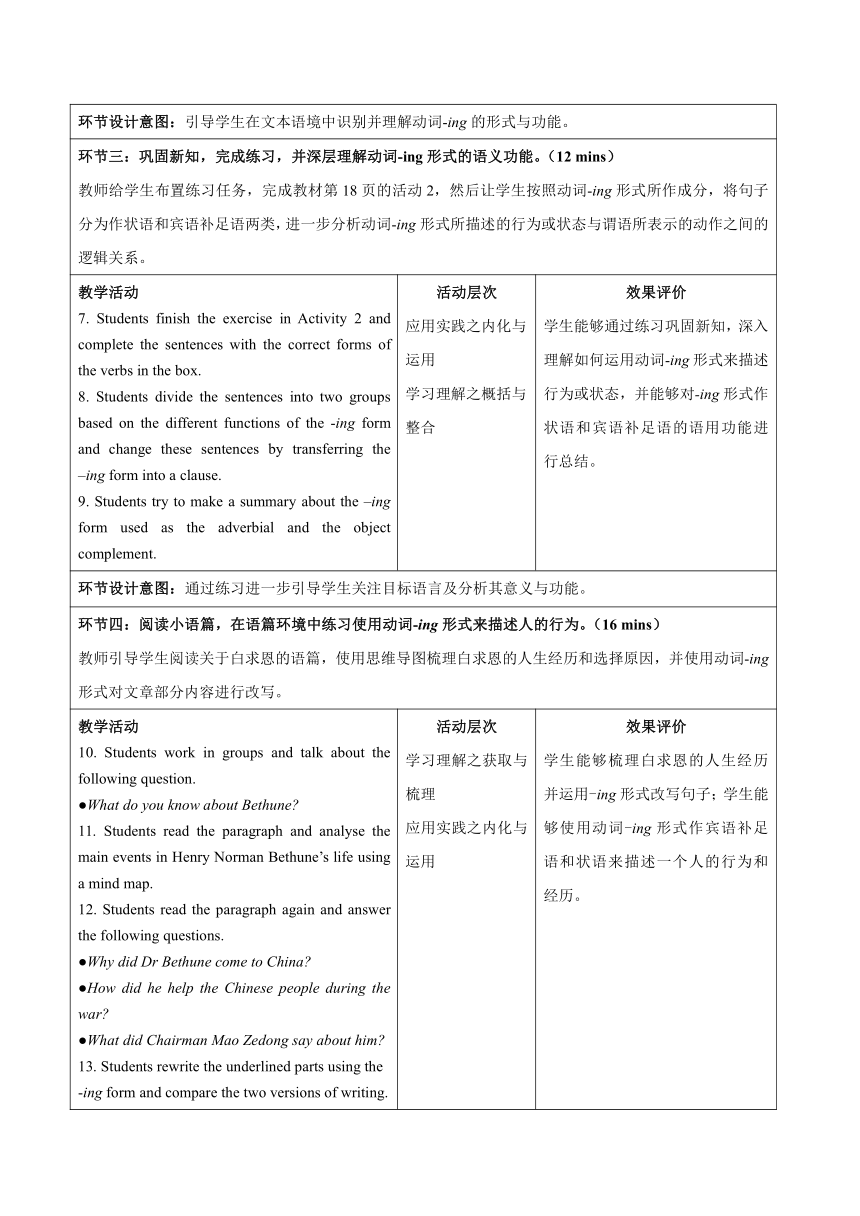人教版(2019)必修第三册Unit 2 Morals and Virtues Discovering Useful Structures 教学设计(表格式)
文档属性
| 名称 | 人教版(2019)必修第三册Unit 2 Morals and Virtues Discovering Useful Structures 教学设计(表格式) |  | |
| 格式 | docx | ||
| 文件大小 | 25.0KB | ||
| 资源类型 | 教案 | ||
| 版本资源 | 人教版(2019) | ||
| 科目 | 英语 | ||
| 更新时间 | 2024-05-05 21:24:34 | ||
图片预览



文档简介
Unit 2 Morals and Virtues
子主题1:优秀人物的美德与人生抉择
Period 4 Discovering Useful Structures
一、教学内容分析
本节课是一节语法课。无论是谈论道德规范,还是人物的美德品质,或是讲述动人的爱心传递事件,往往都需要通过故事来展现。因为只有对人物的言行进行生动而细致的描写,才能深入地刻画人物的性格、品质和精神。本单元主要学习使用动词-ing形式作宾语补足语和状语的用法,用于描述人物的行为和经历。
二、语篇分析
文本内容按照时间顺序介绍了白求恩的一生,重点讲述了白求恩医生在战时为中国提供的帮助,如医院建设及医护人员培训等。他的一系列人生选择也体现了他英雄般的人物形象以及乐于助人的高尚品格。
三、学情分析
已有基础 已有知识:在学习了上单元的语法之后,学生已经可以识别-ing形式作定语和表语的功能和形式。 已有能力:学生可以使用-ing形式作定语和表语来描述一个事件的发生。 存在问题 对于使用-ing形式来描述人物行为和经历及其原因、目的、结果及伴随等不太熟悉。
四、教学目标
通过本课时学习,学生能够: 1. 识别并理解动词-ing形式作宾语补足语和状语的功能和意义; 2. 使用动词-ing形式作宾语补足语和状语来描写人物的行为和经历。
五、教学重难点
【重点】 识别并理解动词-ing形式作宾语补足语和状语的功能和意义。 【难点】 使用动词-ing形式作宾语补足语和状语来描写人物的行为和经历。
六、教学活动设计
环节一:复习前课所学,激活已知,导入本节课语法点。(4 mins) 教师首先引导学生复习上一单元所学有关动词-ing形式作定语和表语的用法,识别动词-ing形式在特定语境中的功能和意义,再通过复现阅读课中的句子,引导学生对比动词-ing形式在句子中所做成分的不同。
教学活动 1. Students have a revision about Lin Qiaozhi’s words and answer the question. ●What do you know from Lin Qiaozhi’s words 2. Students look at the sentences and identify the functions of -ing forms in these sentences. ●Lin Qiaozhi is amazing. These words give us a look into the heart of this amazing woman and what carried her through a life of hard choices. 3. Students discuss in groups about the other functions of the –ing form except for working as predictive and attribute, and try to give some examples. 活动层次 学习理解之感知与注意 效果评价 学生能够正确识别动词-ing形式作定语和表语的用法,并能够通过讨论的方式初步感知动词-ing形式的其它用法。
环节设计意图:导入话题,激活学生关于动词-ing形式在句子中作定语和表语的相关知识,为本节课的语法知识学习做铺垫。
环节二:观察句子,识别句子中动词-ing形式的意义和功能。(8 mins) 教师带领学生一起仔细分析句子中动词-ing的意义和功能,并进行示例分析。学生了解了动词-ing的语法意义和功能后,再次浏览Reading and Thinking部分,找出更多动词-ing形式作状语和宾语补足语的例句。
教学活动 4. Students read three sentences and choose the function of the -ing form from the following options: ●Attribute ●Predicative ●Object complement ●Adverbial 5. Students change each sentence and think about the logic subject of the –ing form and the relationship between the –ing form and its logic subject. 6. Students find more examples with -ing form as the adverbial or the object complement from the unit. 活动层次 学习理解之获取与梳理 应用实践之分析与判断 效果评价 通过复现本单元课文内容,学生能够在语境中识别、理解并分析-ing形式的意义与功能。
环节设计意图:引导学生在文本语境中识别并理解动词-ing的形式与功能。
环节三:巩固新知,完成练习,并深层理解动词-ing形式的语义功能。(12 mins) 教师给学生布置练习任务,完成教材第18页的活动2,然后让学生按照动词-ing形式所作成分,将句子分为作状语和宾语补足语两类,进一步分析动词-ing形式所描述的行为或状态与谓语所表示的动作之间的逻辑关系。
教学活动 7. Students finish the exercise in Activity 2 and complete the sentences with the correct forms of the verbs in the box. 8. Students divide the sentences into two groups based on the different functions of the -ing form and change these sentences by transferring the –ing form into a clause. 9. Students try to make a summary about the –ing form used as the adverbial and the object complement. 活动层次 应用实践之内化与运用 学习理解之概括与整合 效果评价 学生能够通过练习巩固新知,深入理解如何运用动词-ing形式来描述行为或状态,并能够对-ing形式作状语和宾语补足语的语用功能进行总结。
环节设计意图:通过练习进一步引导学生关注目标语言及分析其意义与功能。
环节四:阅读小语篇,在语篇环境中练习使用动词-ing形式来描述人的行为。(16 mins) 教师引导学生阅读关于白求恩的语篇,使用思维导图梳理白求恩的人生经历和选择原因,并使用动词-ing形式对文章部分内容进行改写。
教学活动 10. Students work in groups and talk about the following question. ●What do you know about Bethune 11. Students read the paragraph and analyse the main events in Henry Norman Bethune’s life using a mind map. 12. Students read the paragraph again and answer the following questions. ●Why did Dr Bethune come to China ●How did he help the Chinese people during the war ●What did Chairman Mao Zedong say about him 13. Students rewrite the underlined parts using the -ing form and compare the two versions of writing. 14. Students work in groups, think about a person and describe his or her experience briefly using the –ing form. 活动层次 学习理解之获取与梳理 应用实践之内化与运用 效果评价 学生能够梳理白求恩的人生经历并运用-ing形式改写句子;学生能够使用动词-ing形式作宾语补足语和状语来描述一个人的行为和经历。
环节设计意图:引导学生在语篇中进一步理解使用动词-ing来描述人们的行为和经历的意义和功能。
作业与拓展学习设计 Based on what you have discussed in groups, write a short paragraph to describe the actions and experience of a person you admire using the -ing form.
Worksheet
Unit 2 Discovering Useful Structures
Activity 1: Have a revision
Read and answer the following question.
What do you know from Lin Qiaozhi’s words
Activity 2: Identify and say
Identify the functions of –ing form in the following sentences.
Activity 3: Think and discuss in groups
(1) What are the other functions of the –ing form except for working as predicative and attribute
(2) Can you give some examples to show its functions
Activity 4: Analyse and identify
Read the following sentences and identify the function of -ing form in each sentence. You can choose from the four options.
Activity 5: Change and think
Change each sentence and then think about the logic subject of the –ing form and the relationship between the –ing form and its logic subject.
Activity 6: Skim and find
Skim the unit and find out more –ing forms as the adverbial or the object complement.
Activity 7: Read and complete
Complete the sentences with the correct forms of the verbs in the box. (教材18页活动2)
Activity 8: Divide and change
Step 1: Divide the sentences into two groups based on the different functions of the –ing form filled in the blanks.
Step 2: Change the part with –ing form into a sub-clause.
Activity 9: Make a summary (-ing form)
Activity 10: Discuss and answer
Work in groups and talk about the following question.
What do you know about Bethune
Activity 11: Read and analyse
Read the passage and analyse the main events in Henry Norman Bethune’s life using a mind map.
Activity 12: Read and answer
Read again and answer the following questions.
(1) Why did Dr Bethune come to China
(2) How did he help the Chinese people during the war
(3) What did Chairman Mao Zedong say about him
Activity 13: Rewrite the sentences
Rewrite the underlined parts using the -ing form and compare. (教材18页活动3)
Activity 14: Discuss and share
Work in groups, think about a person you admire and describe his or her experience briefly using the -ing form.
Use the following Evaluation Form to evaluate your classmates’ presentations.
Evaluation form
Item Peer-evaluation Teacher-evaluation
Content / Main idea ☆ ☆ ☆ ☆ ☆ ☆ ☆ ☆ ☆ ☆
Language accuracy: Pronunciation / Vocabulary / Grammar ☆ ☆ ☆ ☆ ☆ ☆ ☆ ☆ ☆ ☆
Use of -ing form as adverbial and object complement ☆ ☆ ☆ ☆ ☆ ☆ ☆ ☆ ☆ ☆
Fluency ☆ ☆ ☆ ☆ ☆ ☆ ☆ ☆ ☆ ☆
Logic and coherence ☆ ☆ ☆ ☆ ☆ ☆ ☆ ☆ ☆ ☆
子主题1:优秀人物的美德与人生抉择
Period 4 Discovering Useful Structures
一、教学内容分析
本节课是一节语法课。无论是谈论道德规范,还是人物的美德品质,或是讲述动人的爱心传递事件,往往都需要通过故事来展现。因为只有对人物的言行进行生动而细致的描写,才能深入地刻画人物的性格、品质和精神。本单元主要学习使用动词-ing形式作宾语补足语和状语的用法,用于描述人物的行为和经历。
二、语篇分析
文本内容按照时间顺序介绍了白求恩的一生,重点讲述了白求恩医生在战时为中国提供的帮助,如医院建设及医护人员培训等。他的一系列人生选择也体现了他英雄般的人物形象以及乐于助人的高尚品格。
三、学情分析
已有基础 已有知识:在学习了上单元的语法之后,学生已经可以识别-ing形式作定语和表语的功能和形式。 已有能力:学生可以使用-ing形式作定语和表语来描述一个事件的发生。 存在问题 对于使用-ing形式来描述人物行为和经历及其原因、目的、结果及伴随等不太熟悉。
四、教学目标
通过本课时学习,学生能够: 1. 识别并理解动词-ing形式作宾语补足语和状语的功能和意义; 2. 使用动词-ing形式作宾语补足语和状语来描写人物的行为和经历。
五、教学重难点
【重点】 识别并理解动词-ing形式作宾语补足语和状语的功能和意义。 【难点】 使用动词-ing形式作宾语补足语和状语来描写人物的行为和经历。
六、教学活动设计
环节一:复习前课所学,激活已知,导入本节课语法点。(4 mins) 教师首先引导学生复习上一单元所学有关动词-ing形式作定语和表语的用法,识别动词-ing形式在特定语境中的功能和意义,再通过复现阅读课中的句子,引导学生对比动词-ing形式在句子中所做成分的不同。
教学活动 1. Students have a revision about Lin Qiaozhi’s words and answer the question. ●What do you know from Lin Qiaozhi’s words 2. Students look at the sentences and identify the functions of -ing forms in these sentences. ●Lin Qiaozhi is amazing. These words give us a look into the heart of this amazing woman and what carried her through a life of hard choices. 3. Students discuss in groups about the other functions of the –ing form except for working as predictive and attribute, and try to give some examples. 活动层次 学习理解之感知与注意 效果评价 学生能够正确识别动词-ing形式作定语和表语的用法,并能够通过讨论的方式初步感知动词-ing形式的其它用法。
环节设计意图:导入话题,激活学生关于动词-ing形式在句子中作定语和表语的相关知识,为本节课的语法知识学习做铺垫。
环节二:观察句子,识别句子中动词-ing形式的意义和功能。(8 mins) 教师带领学生一起仔细分析句子中动词-ing的意义和功能,并进行示例分析。学生了解了动词-ing的语法意义和功能后,再次浏览Reading and Thinking部分,找出更多动词-ing形式作状语和宾语补足语的例句。
教学活动 4. Students read three sentences and choose the function of the -ing form from the following options: ●Attribute ●Predicative ●Object complement ●Adverbial 5. Students change each sentence and think about the logic subject of the –ing form and the relationship between the –ing form and its logic subject. 6. Students find more examples with -ing form as the adverbial or the object complement from the unit. 活动层次 学习理解之获取与梳理 应用实践之分析与判断 效果评价 通过复现本单元课文内容,学生能够在语境中识别、理解并分析-ing形式的意义与功能。
环节设计意图:引导学生在文本语境中识别并理解动词-ing的形式与功能。
环节三:巩固新知,完成练习,并深层理解动词-ing形式的语义功能。(12 mins) 教师给学生布置练习任务,完成教材第18页的活动2,然后让学生按照动词-ing形式所作成分,将句子分为作状语和宾语补足语两类,进一步分析动词-ing形式所描述的行为或状态与谓语所表示的动作之间的逻辑关系。
教学活动 7. Students finish the exercise in Activity 2 and complete the sentences with the correct forms of the verbs in the box. 8. Students divide the sentences into two groups based on the different functions of the -ing form and change these sentences by transferring the –ing form into a clause. 9. Students try to make a summary about the –ing form used as the adverbial and the object complement. 活动层次 应用实践之内化与运用 学习理解之概括与整合 效果评价 学生能够通过练习巩固新知,深入理解如何运用动词-ing形式来描述行为或状态,并能够对-ing形式作状语和宾语补足语的语用功能进行总结。
环节设计意图:通过练习进一步引导学生关注目标语言及分析其意义与功能。
环节四:阅读小语篇,在语篇环境中练习使用动词-ing形式来描述人的行为。(16 mins) 教师引导学生阅读关于白求恩的语篇,使用思维导图梳理白求恩的人生经历和选择原因,并使用动词-ing形式对文章部分内容进行改写。
教学活动 10. Students work in groups and talk about the following question. ●What do you know about Bethune 11. Students read the paragraph and analyse the main events in Henry Norman Bethune’s life using a mind map. 12. Students read the paragraph again and answer the following questions. ●Why did Dr Bethune come to China ●How did he help the Chinese people during the war ●What did Chairman Mao Zedong say about him 13. Students rewrite the underlined parts using the -ing form and compare the two versions of writing. 14. Students work in groups, think about a person and describe his or her experience briefly using the –ing form. 活动层次 学习理解之获取与梳理 应用实践之内化与运用 效果评价 学生能够梳理白求恩的人生经历并运用-ing形式改写句子;学生能够使用动词-ing形式作宾语补足语和状语来描述一个人的行为和经历。
环节设计意图:引导学生在语篇中进一步理解使用动词-ing来描述人们的行为和经历的意义和功能。
作业与拓展学习设计 Based on what you have discussed in groups, write a short paragraph to describe the actions and experience of a person you admire using the -ing form.
Worksheet
Unit 2 Discovering Useful Structures
Activity 1: Have a revision
Read and answer the following question.
What do you know from Lin Qiaozhi’s words
Activity 2: Identify and say
Identify the functions of –ing form in the following sentences.
Activity 3: Think and discuss in groups
(1) What are the other functions of the –ing form except for working as predicative and attribute
(2) Can you give some examples to show its functions
Activity 4: Analyse and identify
Read the following sentences and identify the function of -ing form in each sentence. You can choose from the four options.
Activity 5: Change and think
Change each sentence and then think about the logic subject of the –ing form and the relationship between the –ing form and its logic subject.
Activity 6: Skim and find
Skim the unit and find out more –ing forms as the adverbial or the object complement.
Activity 7: Read and complete
Complete the sentences with the correct forms of the verbs in the box. (教材18页活动2)
Activity 8: Divide and change
Step 1: Divide the sentences into two groups based on the different functions of the –ing form filled in the blanks.
Step 2: Change the part with –ing form into a sub-clause.
Activity 9: Make a summary (-ing form)
Activity 10: Discuss and answer
Work in groups and talk about the following question.
What do you know about Bethune
Activity 11: Read and analyse
Read the passage and analyse the main events in Henry Norman Bethune’s life using a mind map.
Activity 12: Read and answer
Read again and answer the following questions.
(1) Why did Dr Bethune come to China
(2) How did he help the Chinese people during the war
(3) What did Chairman Mao Zedong say about him
Activity 13: Rewrite the sentences
Rewrite the underlined parts using the -ing form and compare. (教材18页活动3)
Activity 14: Discuss and share
Work in groups, think about a person you admire and describe his or her experience briefly using the -ing form.
Use the following Evaluation Form to evaluate your classmates’ presentations.
Evaluation form
Item Peer-evaluation Teacher-evaluation
Content / Main idea ☆ ☆ ☆ ☆ ☆ ☆ ☆ ☆ ☆ ☆
Language accuracy: Pronunciation / Vocabulary / Grammar ☆ ☆ ☆ ☆ ☆ ☆ ☆ ☆ ☆ ☆
Use of -ing form as adverbial and object complement ☆ ☆ ☆ ☆ ☆ ☆ ☆ ☆ ☆ ☆
Fluency ☆ ☆ ☆ ☆ ☆ ☆ ☆ ☆ ☆ ☆
Logic and coherence ☆ ☆ ☆ ☆ ☆ ☆ ☆ ☆ ☆ ☆
